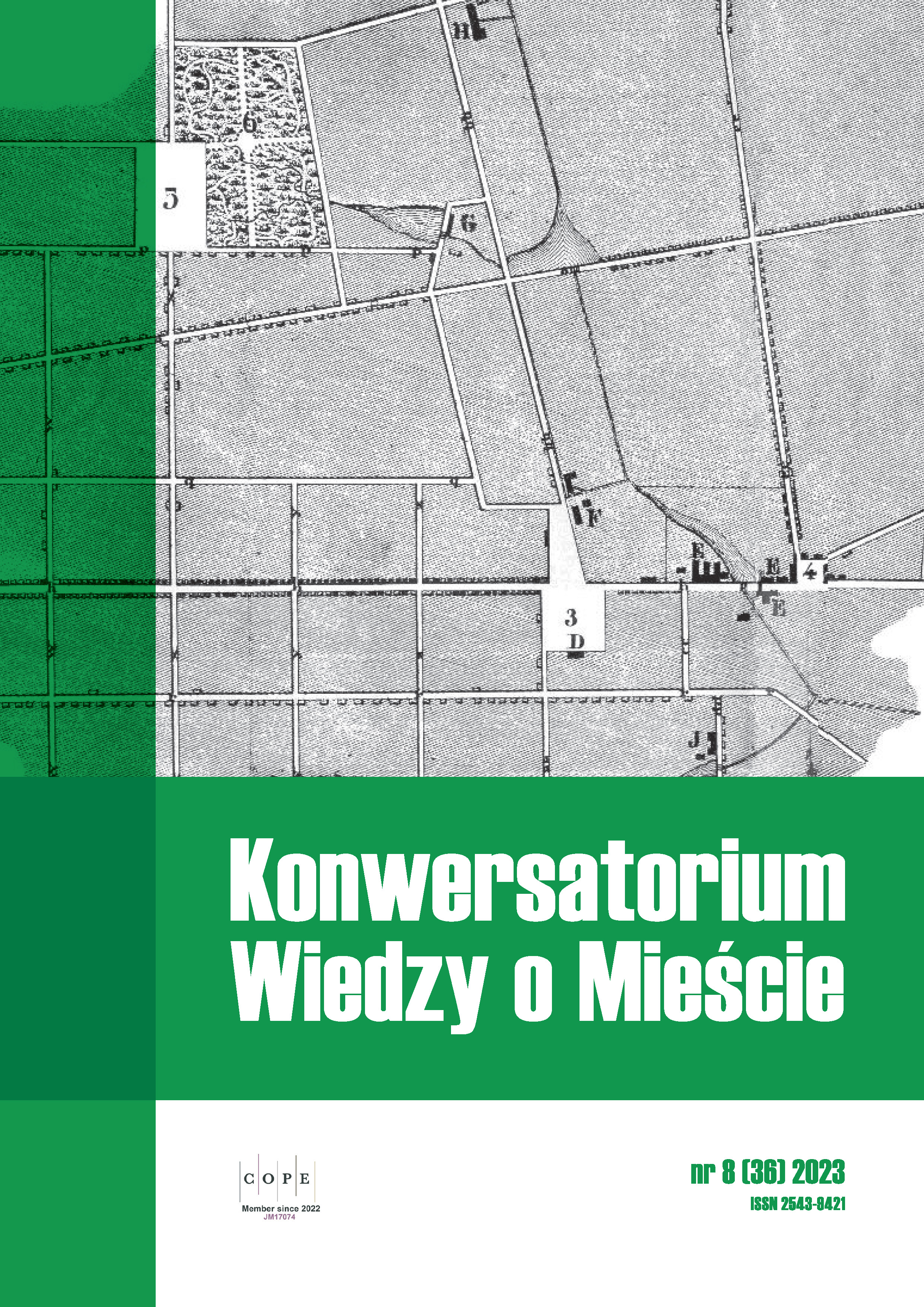Divergence or convergence of the aging population of large cities in Poland?
DOI:
https://doi.org/10.18778/2543-9421.08.01Keywords:
convergence, beta-convergence model, sigma-convergence model, ageing, population structures, large citiesAbstract
In large cities (with at least 100,000 inhabitants), disproportions in population structures are visible, and the ageing population has two dimensions: both ‘from above’ and ‘from below’. The aim of the study is to assess the advancement and diversity of population ageing in large cities in Poland from the perspective of 2050. The research question to be investigated is ‘will large cities in Poland become similar in terms of ageing?’ Beta- and sigma-convergence models were used for variables characterizing indicators of population structure by biological age group (0–14 years, 15–64 years, 65+ and 80+). The obtained results allow us to conclude that from the perspective of 2050 cities will have become similar by equalizing the indicators for mature age groups (80+, 65+ and 15–64 years). This means that in the future large cities will become similar in population by ageing ‘from the top’. At the same time, until 2050, there will be differentiation in the proportion of children (aged 0–14), and that of adults (aged 15–64) in large cities will increase.
References
Barro, R.J., Sala-i-Martin, X. (1992). Convergence. Journal of Political Economy, 100(2), 223–251. https://doi.org/10.1086/261816
Google Scholar
DOI: https://doi.org/10.1086/261816
Bongaarts, J. (2004). Population aging and the rising cost of public pensions. Population and Development Review, 30(1), 1–23. https://doi.org/10.1111/j.1728-4457.2004.00001.x
Google Scholar
DOI: https://doi.org/10.1111/j.1728-4457.2004.00001.x
Borges, G.M. (2018). Theories and measures of demographic convergence: An application to subnational levels in Latin America / Teorías y medidas de convergencia demográfica: Una aplicación a niveles subnacionales en América Latina. W: L. Simpson, L.M. González (red.), ¿Convergencia demográfica? Análisis comparativo de las tendencias demográficas subnacionales en América Latina y el Caribe (s. 31–56). Asociación Latinoamericana de Población. https://files.alapop.org/alap/Serie-E-Investigaciones/N5/e_investigaciones_5_cap1_20_33.pdf
Google Scholar
Börsch-Supan, A. (2003). Labor market effects of population aging. Labour, 17(s1), 5–44. https://doi.org/10.1111/1467-9914.17.specialissue.2
Google Scholar
DOI: https://doi.org/10.1111/1467-9914.17.specialissue.2
Börsch-Supan, A. (2006). Global ageing: What is at stake? Ageing Horizons, 4, 3–5. https://www.ageing.ox.ac.uk/files/AH4%20Borsch-Supan.pdf
Google Scholar
Boyle, G.E., McCarthy, T.G. (1997). Simple measure of β-convergence. Oxford Bulletin Economics and Statistics, 59(2), 257–264. https://doi.org/10.1111/1468-0084.00063
Google Scholar
DOI: https://doi.org/10.1111/1468-0084.00063
Cieślak, M. (2000). Ludność województwa dolnośląskiego w perspektywie 2030 r. Urząd Statystyczny we Wrocławiu. https://reader.digitarium.pcss.pl/Content/138174/172_ludnosc_w_perspektywie_2030-0000-00-0001.pdf
Google Scholar
Dorius, S.F. (2008). Global demographic convergence? A reconsideration of changing intercountry inequality in fertility. Population and Development Review, 34(3), 519–537. https://doi.org/10.1111/j.1728-4457.2008.00235.x
Google Scholar
DOI: https://doi.org/10.1111/j.1728-4457.2008.00235.x
Friedman, M. (1992). Do old fallacies ever die? Journal of Economic Literature, 30, 2129–2132. https://miltonfriedman.hoover.org/internal/media/dispatcher/214983/full
Google Scholar
Furceri, D. (2005). β and σ-convergence: A mathematical relation of causality. Economics Letters, 89(2), 212–215. https://doi.org/10.1016/j.econlet.2005.05.026
Google Scholar
DOI: https://doi.org/10.1016/j.econlet.2005.05.026
Główny Urząd Statystyczny. (2014). Prognoza dla powiatów i miast na prawie powiatu oraz podregionów na lata 2014–2050 (opracowana w 2014 r.). https://stat.gov.pl/obszary-tematyczne/ludnosc/prognoza-ludnosci/prognoza-dla-powiatow-imiast-na-prawie-powiatu-oraz-podregionow-na-lata-20142050-opracowana-w-2014-r-,5,5.html
Google Scholar
Główny Urząd Statystyczny. (2021). Rocznik demograficzny 2021. https://stat.gov.pl/obszary-tematyczne/roczniki-statystyczne/roczniki-statystyczne/rocznik-demograficzny-2021,3,15.html
Google Scholar
Goldstein, J.R., Sobotka, T., Jasilioniene, A. (2009). The end of “lowest-low” fertility? Population and Development Review, 35(4), 663–699. https://doi.org/10.1111/j.1728-4457.2009.00304.x
Google Scholar
DOI: https://doi.org/10.1111/j.1728-4457.2009.00304.x
Gołata, E. (2015). Demograficzne uwarunkowania rozwoju miasta Poznania. Ruch Prawniczy, Ekonomiczny i Socjologiczny, 77(1), 57–77. https://doi.org/10.14746/rpeis.2015.77.1.4
Google Scholar
DOI: https://doi.org/10.14746/rpeis.2015.77.1.4
Gołata, E., Kuropka, I. (2016). Large cities in Poland in face of demographic changes. Bulletin of Geography. Socio-economic Series, 34, 17–31. https://doi.org/10.1515/bog-2016-0032
Google Scholar
DOI: https://doi.org/10.1515/bog-2016-0032
Janiszewska, A. (2019). Starzenie się ludności w polskich miastach. Space − Society − Economy, 29, 45–69. https://doi.org/10.18778/1733-3180.29.03
Google Scholar
DOI: https://doi.org/10.18778/1733-3180.29.03
Janiszewska, A., Dmochowska-Dudek, K. (2017). Przestrzenne zróżnicowanie starzenia się ludności w Łodzi. Space − Society − Economy, 20, 9–22. http://doi.org/10.18778/1733-3180.20.02
Google Scholar
DOI: https://doi.org/10.18778/1733-3180.20.02
Káčerová, M., Ondačková, J., Mládek, J. (2014). Time-space differences of population ageing in Europe. Hungarian Geographical Bulletin, 63(2), 177–199. https://doi.org/10.15201/hungeobull.63.2.4
Google Scholar
DOI: https://doi.org/10.15201/hungeobull.63.2.4
Kashnitsky, I., de Beer, J., van Wissen, L. (2017). Decomposition of regional convergence in population aging across Europe. Genus, 73, artykuł 2. https://doi.org/10.1186/s41118-017-0018-2
Google Scholar
DOI: https://doi.org/10.1186/s41118-017-0018-2
Kotowska, I.E. (red.). (1999). Przemiany demograficzne w Polsce w latach 90. w świetle koncepcji drugiego przejścia demograficznego [zeszyt specjalny]. Monografie i Opracowania / Szkoła Główna Handlowa, 461.
Google Scholar
Kurek, S. (2008). Typologia starzenia się ludności Polski w ujęciu przestrzennym. Wydawnictwo Naukowe Akademii Pedagogicznej.
Google Scholar
Kurek, S. (2011). Zmiany w strukturze wieku ludności w miastach Polski na tle procesów suburbanizacji. Studia Miejskie, 3, 81–97. https://czasopisma.uni.opole.pl/index.php/sm/article/view/2288
Google Scholar
Kusideł, E. (2013). Konwergencja gospodarcza w Polsce i jej znaczenie w osiąganiu celów polityki spójności. Wydawnictwo Uniwersytetu Łódzkiego. http://doi.org/10.18778/7525-877-6
Google Scholar
DOI: https://doi.org/10.18778/7525-877-6
Lee, R., Mason, A. (2010). Fertility, human capital, and economic growth over the demographic transition. European Journal of Population / Reveu européenne de Démographie, 26, 159–182. http://doi.org/10.1007/s10680-009-9186-x
Google Scholar
DOI: https://doi.org/10.1007/s10680-009-9186-x
Lesthaeghe, R. (1991). The second demographic transition in western countries: An interpretation (Vrije Universitet Brussel Interuniversity Programme in Demography Working Papers No. 1991-2). https://interfacedemography.be/wp-content/uploads/2016/02/WP-IPD-1991-2.pdf
Google Scholar
Lutz, W., Skirbekk, V., Testa, M.R. (2006). The low-fertility trap hypothesis: Forces that may lead to further postponement and fewer births in Europe. Vienna Yearbook of Population Research, s. 167–192. https://doi.org/10.1553/populationyearbook2006s167
Google Scholar
DOI: https://doi.org/10.1553/populationyearbook2006s167
Majdzińska, A. (2021). Ocena homogeniczności regionów w Polsce z punktu widzenia struktury wieku ludności. Space − Society − Economy, 32, 131–151. https://doi.org/10.18778/1733-3180.32.06
Google Scholar
DOI: https://doi.org/10.18778/1733-3180.32.06
Podogrodzka, M. (2016a). Przestrzenna konwergencja indeksu starości w Polsce. Acta Universitatis Lodziensis. Folia Oeconomica, 324(4), 51–65. http://hdl.handle.net/11089/21227
Google Scholar
DOI: https://doi.org/10.18778/0208-6018.324.04
Podogrodzka, M. (2016b). Starość demograficzna w Polsce. Ujęcie przestrzenne. Studia i Prace WNEiZ US, 45(2), 409–429. https://doi.org/10.18276/sip.2016.45/2-32
Google Scholar
DOI: https://doi.org/10.18276/sip.2016.45/2-32
Posada, D.G., Morollon, F.R., Viñuela, A. (2017). Ageing places in an ageing country: The local dynamics of the elderly population in Spain. Tijdschrift voor economische en sociale geografie / Journal of Economic and Human Geography, 109(3), 332–349. https://doi.org/10.1111/tesg.12294
Google Scholar
DOI: https://doi.org/10.1111/tesg.12294
Preston, S.H., Himes, C., Eggers, M. (1989). Demographic conditions responsible for population aging. Demography, 26, 691–704. https://link.springer.com/article/10.2307%2F2061266?LI=true
Google Scholar
DOI: https://doi.org/10.2307/2061266
Quah, D. (1993). Galton’s fallacy and tests of the convergence hypothesis. The Scandinavian Journal of Economics, 95(4), 427–443. https://doi.org/10.2307/3440905
Google Scholar
DOI: https://doi.org/10.2307/3440905
Sala-i-Martin, X. (1996). The classical approach to convergence analysis. The Economic Journal, 106(437), 1019–1036. https://doi.org/10.2307/2235375
Google Scholar
DOI: https://doi.org/10.2307/2235375
Strzelecka, A. (2021). The field of “public health” as a component of sustainable development – Poland compared to the European Union. Sustainability, 13(18), artykuł 10351. https://doi.org/10.3390/su131810351
Google Scholar
DOI: https://doi.org/10.3390/su131810351
Szukalski, P. (2010). Starzenie się ludności Łodzi na tle największych polskich miast od początku XX wieku. Acta Universitatis Lodzensis. Folia Sociologica, 35, 103–125. http://hdl.handle.net/11089/264
Google Scholar
Szukalski, P. (2017). Starzenie się ludności miast wojewódzkich – przeszłość, teraźniejszość, przyszłość. Demografia i Gerontologia Społeczna – Biuletyn Informacyjny, 12, 103–125. http://hdl.handle.net/11089/24279
Google Scholar
Szukalski, P. (2018). Przyszłość demograficzna stolic województw: Na ile należy wierzyć w wyniki prognoz? Demografia i Gerontologia Społeczna – Biuletyn Informacyjny, 2, 1–6. http://hdl.handle.net/11089/24791
Google Scholar
van de Kaa, D.J. (1987). Europe’s second demographic transition. Population Bulletin, 42(1), 1–59.
Google Scholar
Wasilewska, E. (2017). Demographical ageing of the EU member states’ societies. Zeszyty Naukowe SGGW w Warszawie – Problemy Rolnictwa Światowego / Scientific Journal Warsaw University of Life Sciences – SGGW – Problems of World Agriculture, 17(4), 302–315. https://doi.org/10.22630/PRS.2017.17.4.106
Google Scholar
DOI: https://doi.org/10.22630/PRS.2017.17.4.106
Wolańska, W. (2013). Przestrzenne zróżnicowanie starzenia się ludności Polski w latach 1995–2035. Acta Universitatis Lodziensis. Folia Oeconomica, 291, 249–263. http://hdl.handle.net/11089/4373
Google Scholar
Wójtowicz, M., Kurek, S., Gałka, J. (2019). Proces starzenia się ludności miejskich obszarów funkcjonalnych (MOF) w Polsce w latach 1990–2016. Studia Miejskie, 33, 9–38. https://doi.org/10.25167/sm.944
Google Scholar
DOI: https://doi.org/10.25167/sm.944
Zborowski, A. (2005). Quo vadis Cracovia, czyli prognoza ludności miasta. Geografia i Sacrum, 191–202. https://ruj.uj.edu.pl/xmlui/bitstream/handle/item/254197/zborowski_quo_vadis_cracovia_2005.pdf?sequence=1&isAllowed=y
Google Scholar
Downloads
Published
How to Cite
Issue
Section
License

This work is licensed under a Creative Commons Attribution-NonCommercial-NoDerivatives 4.0 International License.









